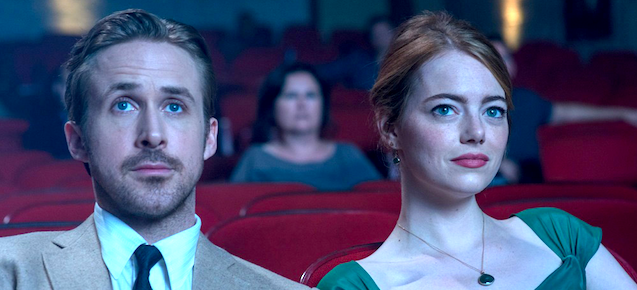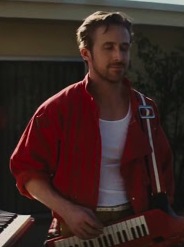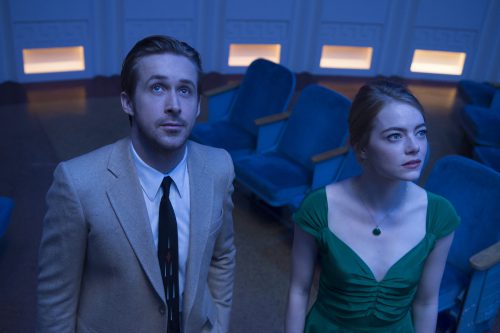
In the end of Damien Chazelle’s La La Land, Ryan Gosling and Emma Stone get what they’ve always wanted. Once it’s theirs, though, they realize it’s not what they were expecting. Stone’s imagination steers us through the final scene, a montage of what could have been. It’s funny and heartbreaking, in turns. Her quirky, unsuccessful play premiers to a sold out auditorium, and Gosling’s depressing gig playing mood music at a lousy restaurant wins impossible acclaim. It’s not what actually happened, and it’s not the way things ever happen.
Happy endings are the stuff of fairytales. And though it feels like a fairy tale at times, La La Land communicates the gritty, gospel truth that Jesus works in unexpected ways, incessantly defying expectations. In this way, it’s a profoundly optimistic and uplifting movie. Chazelle achieves this not through the Hollywood veneer of bright lights and colorful sets, motifs the film deftly riffs on, or an always sunny and thus incontrovertibly fake representation of life, but because its characters saw and experienced the most beauty before they met with worldly success, when they turned from overblown ideas of self-importance and what they should be doing, to the opportunities staring them right in the face.
We meet Gosling and Stone as young dreamers in Los Angeles struggling to make it in show business. Gosling is a brilliant piano player with romantic notions about opening up his own jazz club. Stone is an aspiring actress who’s working at a coffee shop in Burbank and taking any audition she can get. Their ambitions are larger than life, and we love this about them, but also kinda wish they would take it down a notch – they’re setting themselves up for disappointment. Stone frolics around a lavish party, drinking, dancing and singing – then the music ends, and her Prius has been towed. Gosling breaks from mandated Christmas carols at the restaurant into a virtuosic jazz solo – then the music ends, and J.K. Simmons fires him. You remember Simmons from his role as the brutal music instructor in Chazelle’s Whiplash, which Will McDavid memorably wrote up.
In a recent sermon, Paul Walker captured this paradox of reaching for something and ending up in stasis, enslaved to it. Leaping off from a Bob Dylan lyric, he preached,
“You’re gonna have to serve somebody. Despite all the free will and self-empowerment talk that we Americans hold so dear, not a single person is capable of being the captain of his own soul or the master of his own destiny… Thornton Wilder describes this so well in The Bridge of San Luis Rey. Writing about his main character, he says, “She saw that the people of this world moved about in an armor of egotism, drunk with self-gazing…. in dread of all appeals that might interrupt their long communion with their own desires.” These people sound a little like zombies. But Wilder nails it. He unmasks the myth that service to the self leads to fulfillment and happiness. Instead, the long communion with our own desires leads to not to fulfillment but gnawing malediction and bondage.”
Gosling’s character embraces this zombie-like communion with his own unrealistic dreams. He’s behind on bills and resents the appeals of a friend to try to get him a real job. “I want to be on the ropes,” he says. Gosling has an old stool sitting on the counter in his apartment that Hoagy Carmichael once sat on, and his friend comes in, places it on the floor and sits on it. He freaks. We laugh at his impracticality, but we cry for his earnestness. He wants to stay in the bubble of his own thoughts and dreams. At least the music will be good.
Stone is the same way. She dreams of becoming a movie star, but producers won’t give her the time of day, and she’s stifled by the law of comparison – constantly measuring herself against the scores of others auditioning for the same parts and the stars who frequent the coffee shop where she works. When Stone meets Ryan Gosling, she’s dating Finn Whitrock (so she’s really caught between a rock and a hard place there). But a few of her interactions with Gosling beautifully illustrate that we’re not the masters of our own ships and that God works in our lives in mysterious ways.
First, Gosling invites Stone on a casual (yet also super cute and romantic) date to see Rebel Without a Cause at a picturesque old theater. She forgets, however, that she already has dinner plans with her boyfriend and his visiting brother. They go to a bourgie downtown spot, the drinks are flowing and everybody looks very put together – Emma Stone can’t leave fast enough. She meets Gosling at the movie and they watch an early scene with a car driving up to the Griffith Observatory before the screen gets all blotchy and the lights come up. Forced to punt, they leave and make their way to the ac tual Griffith Observatory, recreating the drive-up shot and then exploring the planetarium.
tual Griffith Observatory, recreating the drive-up shot and then exploring the planetarium.
Of course, simulating a Rebel Without a Cause scene makes for great cinema and a romantic date activity, but they’re also making the best of a situation they didn’t plan for. She’s shunning one lifestyle – the comfortable Whitrock who can support her financially and let her amuse herself with acting auditions before she gives up on her dreams and settles into something safer – for the broke Gosling who’s playing for peanuts at d-list pool parties, but he believes in her and mirrors her desperate dreamer side. To her boyfriend and her family back home, her acting aspirations are empty dreams; to Gosling, they’re the most important thing. His honest vulnerability, I’m sure, brings down her defenses as well. Their relationship blossoms out of this mutual need, seeing themselves in each other and seizing on some hopeful honesty.
When they finally have opportunities to realize their dreams, they need the other’s help to tear through the packaging and see what’s really been gifted them. After her passion-project play flops, Stone feels defeated and leaves the city. Gosling hears improbably from some movie people impressed with the play that they want Stone for a marquee role. This is the opportunity she’s been waiting for. So, in a total act of love, Gosling drives to her small town in Nevada, finding her house by remembering a tiny detail in a story she told months earlier. He relays the great news, but she doesn’t want to hear it. She’s over it. Done. “Start making sense!” he implores her with the refreshing candor characteristic of Chazelle’s screenplay. “I’m gonna be back here at 8am and if you’re not waiting outside, I’m leaving,” he says. The next morning she’s there with coffee and bagels in hand.
Five years pass, and the characters who emerge have grown up. In a way, they’ve achieved their dreams, but the reality of their successes turns out not to be very dream-like.
Although the movie takes us on an undeniably joyful nostalgia trip, the gravity of the condition Gosling and Stone are left in strikes a chord. We recognize it so clearly because it’s the same as ours. “City of stars, are you shining just for me?” Gosling sings in the movie’s theme, brimming with youthful hope and ambition. Then, on a sad, resonant note, he asks, “Is this the start of something wonderful and new, or one more dream that I cannot make true?” Its title alludes to this wonderful, new dream world that the lovers inhabit, but Chazelle’s La La Land surpasses the promise of its glossy packaging to, indeed, make something true.

COMMENTS
3 responses to “The Sad Optimism of La La Land”
Leave a Reply















Finally saw it tonight, Dave. The film packs quite a bittersweet punch! As does your review. Thank you.